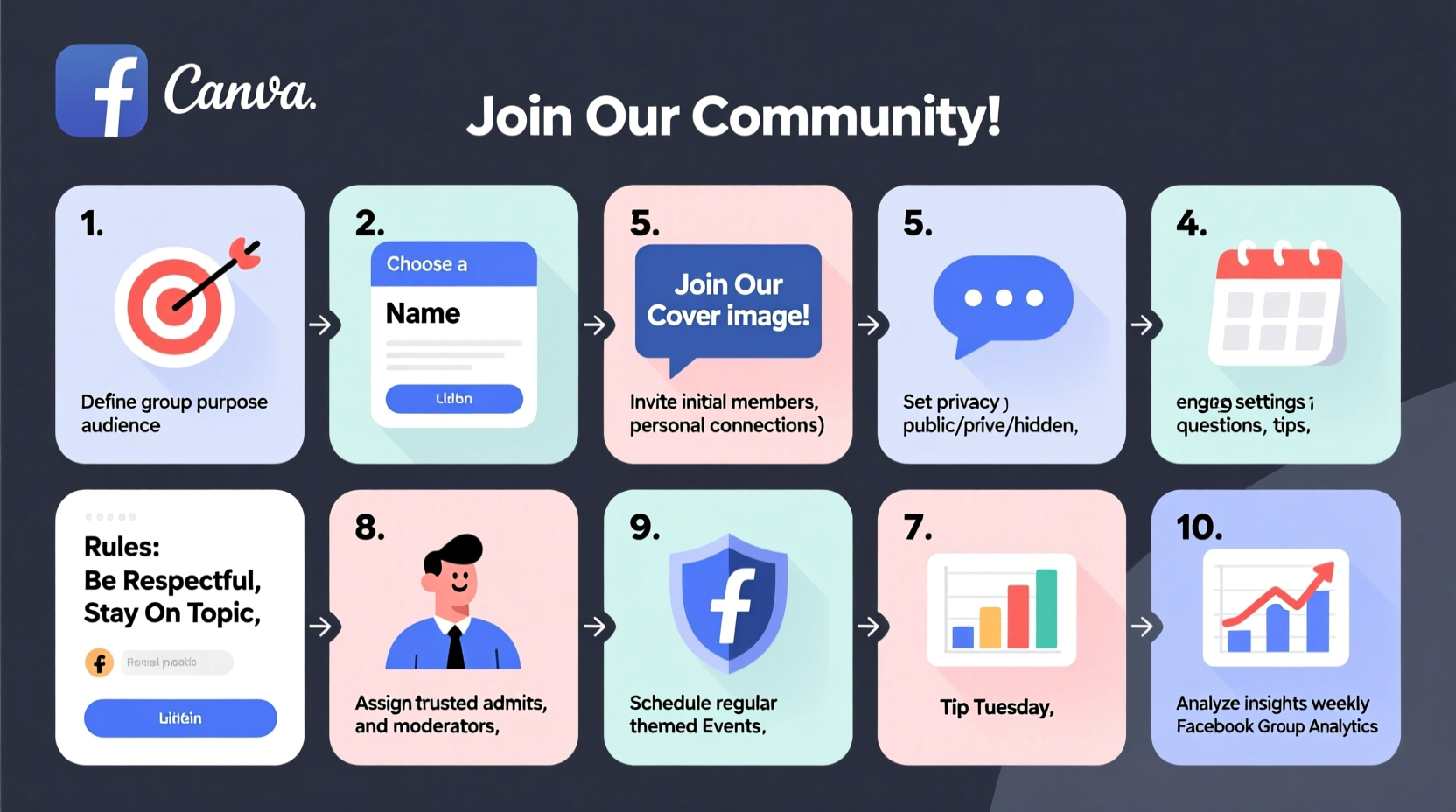Facebook Groups remain one of the most powerful tools for building community, fostering engagement, and growing influence—whether you're promoting a brand, supporting a cause, or connecting like-minded individuals. While many groups start with enthusiasm, only a fraction achieve lasting impact. Success comes not from luck, but from strategy, consistency, and thoughtful management. This guide walks through the essential steps to create, grow, and sustain a thriving Facebook Group that delivers real value to its members.
1. Define Your Purpose and Target Audience

Before clicking \"Create Group,\" clarify why your group exists. A clear purpose acts as your compass for content, tone, and member expectations. Ask: Who are you serving? What problems will this group solve? What kind of conversations do you want to encourage?
A well-defined audience ensures relevance. For example, a group titled “Remote Work Tips for Digital Nomads” speaks directly to location-independent professionals seeking productivity advice. Vague titles like “Work From Home Chat” attract passive scrollers rather than engaged contributors.
- Identify the core need your group fulfills (e.g., support, education, networking)
- Define your ideal member: profession, interests, challenges
- Determine whether the group will be public, private, or hidden
2. Set Up Your Group Strategically
The initial setup shapes first impressions and long-term functionality. Use this phase to lay a strong foundation.
- Name & Description: Choose a name that’s searchable and descriptive. Include keywords people might search for. The description should clearly state the group’s purpose, rules, and benefits of joining.
- Cover Photo & Icon: Design visuals that reflect your brand or theme. Use consistent colors and fonts to build recognition.
- Privacy Settings: Most successful communities opt for “Private – Visible” so content is secure but discovery is possible.
- Group Rules: Establish clear guidelines early. Require new members to agree to them upon joining.
- Tags & Categories: Add relevant tags (e.g., Entrepreneurship, Wellness) to improve discoverability in Facebook search.
| Setting | Recommended Option | Why It Matters |
|---|---|---|
| Privacy | Private (Visible) | Balances security with visibility for growth |
| Membership Approval | Manual Approval | Prevents spam and bots |
| Post Approval | Moderator Review (Optional) | Maintains quality in early stages |
| Content Sharing | Members Only | Encourages open discussion without fear of exposure |
3. Launch with Momentum and Onboarding
A launch without momentum fades quickly. Seed your group with valuable content before inviting members. Post welcome messages, introductory threads, and starter discussions.
When onboarding new members, automate where possible. Use Facebook’s “Welcome Message” feature to send a personalized note explaining group norms and encouraging participation.
“Groups that actively guide new members toward their first interaction see 3x higher retention.” — Sarah Lin, Community Growth Strategist
First 7-Day Launch Plan
- Day 1: Welcome post + introduce yourself
- Day 2: Share a high-value tip or resource
- Day 3: Start a discussion: “What brings you here?”
- Day 4: Feature a member spotlight (invite a friend to participate)
- Day 5: Post a poll or quick question
- Day 6: Share a story or challenge you’ve overcome
- Day 7: Announce a weekly theme or recurring event
4. Drive Engagement and Sustain Activity
Active groups thrive; stagnant ones die. Engagement isn’t accidental—it’s engineered through consistent prompts, recognition, and rhythm.
Create recurring content formats such as:
- “Tip Tuesday” – Members share best practices
- “Feedback Friday” – Peer reviews or Q&A
- Weekly challenges or themed discussions
Mini Case Study: The Freelance Writers Circle
A small writing group struggled with low activity after an initial surge. The admin introduced “Client Win Wednesday,” where members shared recent successes. Within three weeks, daily comments doubled. The simple ritual created celebration, inspiration, and connection. One member said, “Seeing others succeed made me want to contribute more.”
5. Grow Authentically and Measure Progress
Organic growth beats rapid, artificial expansion. Invite people personally. Share value-driven posts in related groups (without spamming). Collaborate with influencers or partners who align with your niche.
Track key metrics monthly:
- Member growth rate
- Posts per day
- Engagement rate (likes, comments, shares)
- New member participation within first 48 hours
- ✅ Are new members welcomed automatically or manually?
- ✅ Are rules visible and enforced consistently?
- ✅ Is there at least one moderator response per day?
- ✅ Are off-topic or promotional posts redirected appropriately?
- ✅ Is valuable content being pinned or highlighted?
- ✅ Are inactive members periodically reviewed?
FAQ: Common Questions About Facebook Groups
How often should I post in my group?
Aim for 1–2 high-quality posts per day. Quality matters more than quantity. Encourage member-led discussions to reduce admin burden.
What’s the best way to handle conflict or negative comments?
Respond promptly but calmly. Refer to your group rules. If necessary, remove the comment or member privately. Always explain decisions transparently when appropriate, without escalating drama.
Can I promote my business in my own group?
Yes, but sparingly. Follow the 80/20 rule: 80% value-driven content, 20% promotional. Over-promotion erodes trust and engagement.
Conclusion: Build With Intention, Lead With Value
A successful Facebook Group isn’t built overnight. It grows from intentionality—from knowing who you serve and why they should stay. Every decision, from naming to moderating, shapes the culture. Focus on delivering consistent value, empowering members, and nurturing relationships over time.
Don’t chase numbers. Chase meaning. A group of 200 deeply engaged members will outperform 5,000 passive followers every time. Start small, stay consistent, and let authenticity lead the way.









 浙公网安备
33010002000092号
浙公网安备
33010002000092号 浙B2-20120091-4
浙B2-20120091-4
Comments
No comments yet. Why don't you start the discussion?